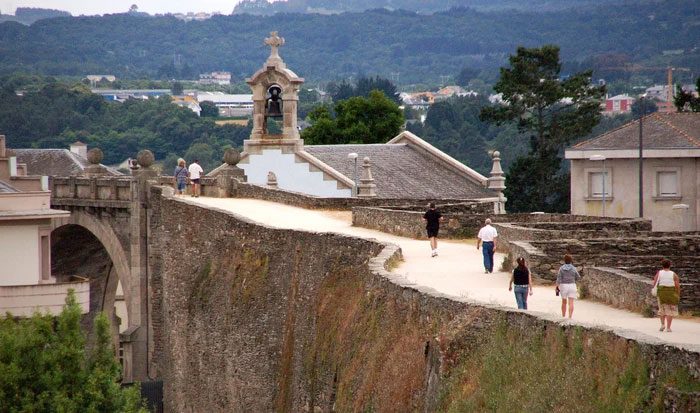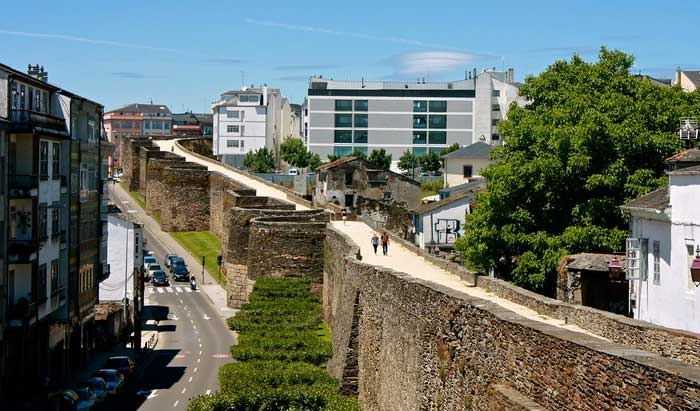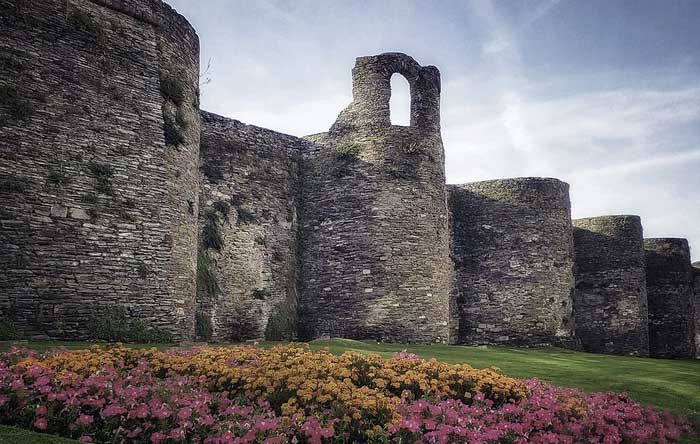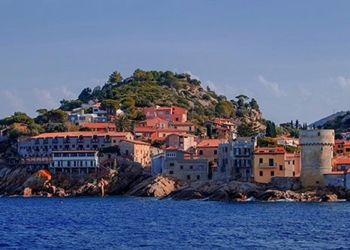Built nearly 2000 years ago, these walls surround the entire historic center of Lugo in Spain.
Lugo is a city located in the autonomous community of Galicia in the northwest of Spain. It is the only city in the world completely surrounded by well-preserved Roman walls – reaching heights of 10 to 15 meters along a length of 2,117 meters and featuring a total of 85 towers.
Visitors can stroll along the entire length via a walkway on the walls.

The Roman walls in Lugo are a system built in the 3rd century and have remained largely intact to this day. The system stretches over 2 km around the historic center of Lugo in Galicia. The fortifications and wall system of Lugo were inscribed on the UNESCO World Heritage List at the end of 2000 as the “best example of Roman fortifications in Western Europe.”
These ancient walls date back to the 3rd and 4th centuries AD and represent a unique architectural and archaeological heritage of Roman engineering. They were constructed using local materials such as slate, granite, and other stones – even incorporating pieces from Roman buildings – reused during the construction, giving the walls of the late Roman period an authentic appearance.
The defensive system (the city walls) of Lugo has been recognized by UNESCO as a World Heritage Site. They are the most complete and best-preserved example of Roman military architecture in the Western Roman Empire.

The walls have been designated a national monument in Spain since 1921. Today, there is a walkway on the walls that allows visitors to stroll along their entire length. Since the wall system in Lugo was listed as a World Heritage Site in 2000, the town has held an annual festival called Arde Lucus to celebrate its Roman past.
Despite restoration efforts over the centuries, the walls have preserved their original layout and features related to their defensive purpose. In addition to the walls, there are defensive towers, battlements, fortifications, original gates, and stairways, as well as a moat. Within the walls, some double staircases provide access to the towers from the walkway with railings.
Since their construction, the Roman walls have defined the layout and development of the city, which was declared an Artistic-Historical Ensemble in 1973. Locals and visitors have used them as a recreational area and a part of urban life for centuries.

There are 10 gates in the walls: 5 gates were built during Roman times, and 5 others were added in 1853 after the city’s population rapidly increased. Of the original watchtowers, 49 remain intact, with 39 others partially preserved. The towers were constructed over different periods along the walls, including two main semi-circular structures, with a few rectangular ones.
According to legend, the Romans built these walls not to protect a city but a forest – “The Sacred Forest of Augustus.” And while this forest remains a mystery today, the walls certainly stand strong, defying time and the transformations of human society.
|
Augustus (63 BC – 14 AD) was the first emperor of ancient Rome. He replaced the Roman Republic with an effective monarchy, bringing peace and stability throughout his reign. Augustus was born on September 23, 63 BC in Rome, named Gaius Octavius. In 43 BC, Julius Caesar was assassinated, and according to his will, his grandnephew Octavius (also known as Octavian) was named his heir. Octavian fought to avenge Caesar, and by 31 BC, he had defeated Antony and Cleopatra at the Battle of Actium. From then on, he officially became the ruler of the ancient Roman Empire. Rather than following Caesar’s footsteps to become a dictator, Octavian established the foundations of the “principate”, a monarchy in which the emperor would rule and hold power for life. His power was concealed behind a constitutional system, adopting the title Augustus, which means “the revered one” or “the majestic.” Nevertheless, he controlled every aspect of the Roman Empire, with the army under his direct command. |





















































